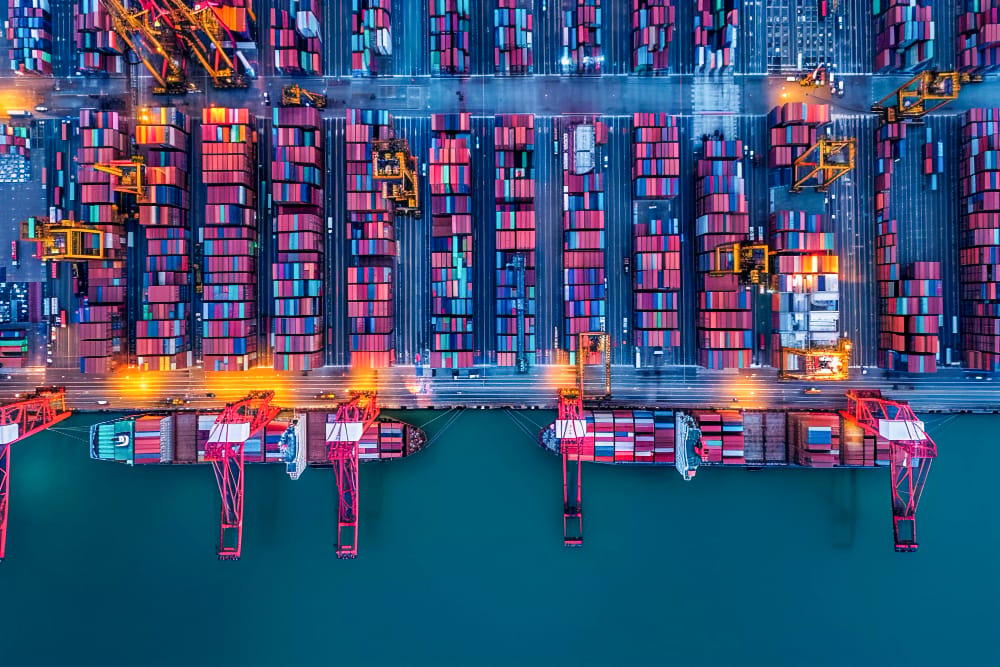1. Port of Los Angeles, California
The Port of Los Angeles is the busiest port in the United States and the primary gateway for trans-Pacific trade. In 2024, it handled over 10 million TEUs, driven largely by imports from China, South Korea, Vietnam, and Japan. Located in San Pedro Bay, it is critical for consumer goods like electronics, furniture, textiles, and auto parts entering the U.S. market.
Its extensive rail connections via BNSF and Union Pacific enable cargo to move rapidly to major inland hubs like Chicago, Dallas, and Memphis. The port’s scale, automation projects, and deep-water terminals make it the backbone of U.S.–Asia shipping and a central player in national supply chain efficiency.
2. Port of Long Beach, California
Right next to Los Angeles, the Port of Long Beach is the second-largest port in the U.S. and a vital part of the San Pedro Bay complex. It handles around 8–9 million TEUs annually and is renowned for its green port initiatives and automated terminals like the Long Beach Container Terminal (LBCT).
The majority of its imports come from East Asian nations and include consumer electronics, machinery, clothing, and retail goods. Like Los Angeles, it has direct double-stack rail access and is essential for U.S. retailers such as Walmart, Target, and Amazon to restock distribution centers across the country. Its operations directly support over 2.6 million U.S. jobs and billions in trade value.
3. Port of Oakland, California
The Port of Oakland is the main container port for Northern California and a key export hub for U.S. agriculture. It processes over 2.3 million TEUs annually, with imports largely consisting of machinery, electronics, beverages, and apparel from Asia. Oakland is strategically important because cargo arriving here serves the San Francisco Bay Area, Silicon Valley, and the Central Valley agricultural regions.
Unlike Los Angeles and Long Beach, Oakland handles more exports of food products, meat, and wine. Its location reduces transit times for goods entering Northern California and the Pacific Northwest, and its direct rail links (Union Pacific and BNSF) make it an efficient gateway for inland shipments.
4. Northwest Seaport Alliance (Ports of Seattle & Tacoma, Washington)
The Northwest Seaport Alliance combines the Ports of Seattle and Tacoma, making it the fourth-largest container gateway in the country. Together, they handle about 3.5–4 million TEUs annually. They serve as a key entry point for imports from China, South Korea, Japan, and Vietnam, primarily consumer goods, industrial machinery, vehicle parts, and refrigerated cargo.
Tacoma handles more ocean-going container traffic, while Seattle focuses on logistics, warehousing, and cruise operations. These ports also serve major companies like Boeing, Costco, Microsoft, and Starbucks by supporting both imports and exports from the Pacific Northwest. Their proximity to Canada makes them a strategic alternative to Southern California ports.
Why U.S. West Coast Ports Matter
These ports handle more than 40% of all U.S. containerized imports and form the backbone of America’s trade with Asia. Their efficiency affects everything from store shelves to factory supply chains and agricultural exports. Congestion, labor strikes, or geopolitical tensions in these ports can ripple across U.S. railways, trucking networks, and national inventories — making them some of the most strategically important logistics hubs in the world.
U.S. West Coast Ports FAQs
Why are West Coast ports important to the U.S. economy?
Because they handle over 40% of all U.S. container imports, especially from Asia, they keep stores stocked and factories supplied.
Which is the biggest West Coast port?
The Port of Los Angeles is the largest, handling over 10 million TEUs a year, followed closely by the Port of Long Beach.
What goods arrive at the US West Coast ports?
Mainly electronics, machinery, clothing, furniture, vehicles, and retail goods from China, South Korea, Japan, and other Asian countries.
